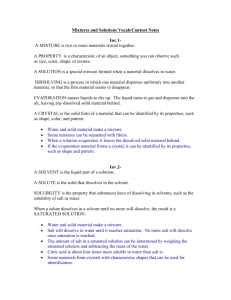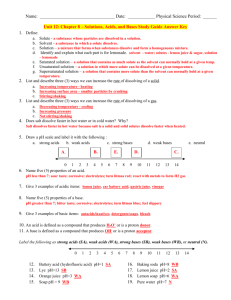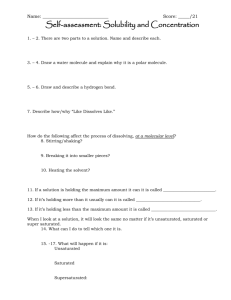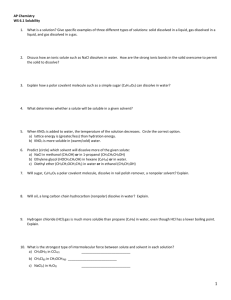3.5 Solutions and crystals - Basic Science & Technology
advertisement
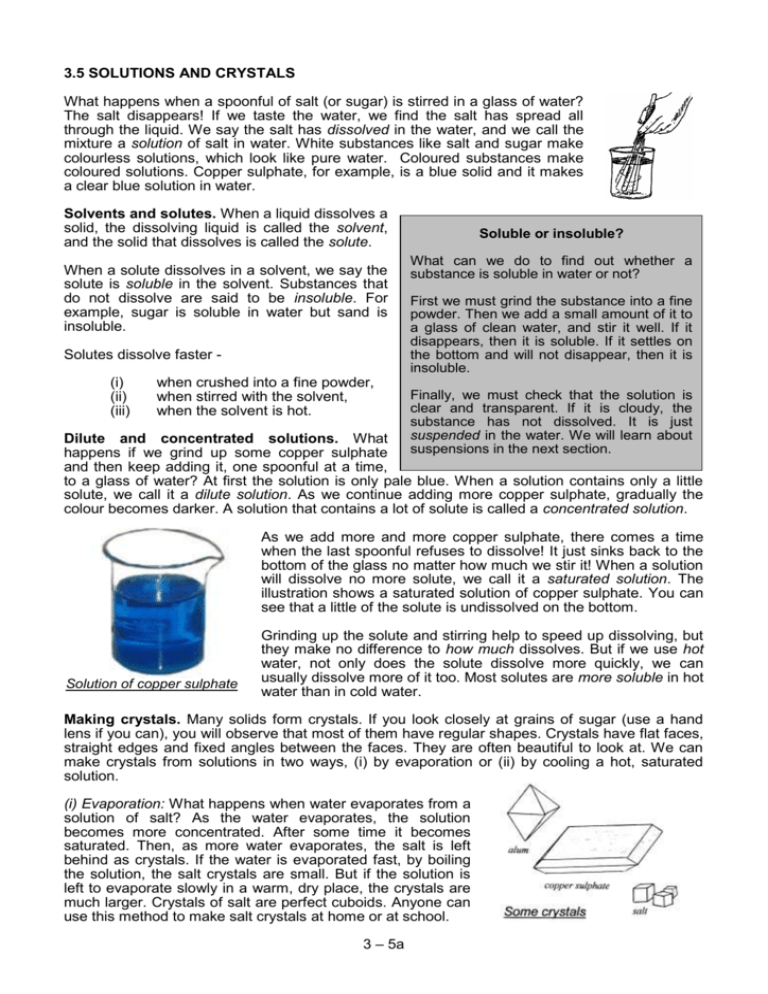
3.5 SOLUTIONS AND CRYSTALS What happens when a spoonful of salt (or sugar) is stirred in a glass of water? The salt disappears! If we taste the water, we find the salt has spread all through the liquid. We say the salt has dissolved in the water, and we call the mixture a solution of salt in water. White substances like salt and sugar make colourless solutions, which look like pure water. Coloured substances make coloured solutions. Copper sulphate, for example, is a blue solid and it makes a clear blue solution in water. Solvents and solutes. When a liquid dissolves a solid, the dissolving liquid is called the solvent, and the solid that dissolves is called the solute. When a solute dissolves in a solvent, we say the solute is soluble in the solvent. Substances that do not dissolve are said to be insoluble. For example, sugar is soluble in water but sand is insoluble. Solutes dissolve faster (i) (ii) (iii) when crushed into a fine powder, when stirred with the solvent, when the solvent is hot. Soluble or insoluble? What can we do to find out whether a substance is soluble in water or not? First we must grind the substance into a fine powder. Then we add a small amount of it to a glass of clean water, and stir it well. If it disappears, then it is soluble. If it settles on the bottom and will not disappear, then it is insoluble. Finally, we must check that the solution is clear and transparent. If it is cloudy, the substance has not dissolved. It is just suspended in the water. We will learn about suspensions in the next section. Dilute and concentrated solutions. What happens if we grind up some copper sulphate and then keep adding it, one spoonful at a time, to a glass of water? At first the solution is only pale blue. When a solution contains only a little solute, we call it a dilute solution. As we continue adding more copper sulphate, gradually the colour becomes darker. A solution that contains a lot of solute is called a concentrated solution. As we add more and more copper sulphate, there comes a time when the last spoonful refuses to dissolve! It just sinks back to the bottom of the glass no matter how much we stir it! When a solution will dissolve no more solute, we call it a saturated solution. The illustration shows a saturated solution of copper sulphate. You can see that a little of the solute is undissolved on the bottom. Solution of copper sulphate Grinding up the solute and stirring help to speed up dissolving, but they make no difference to how much dissolves. But if we use hot water, not only does the solute dissolve more quickly, we can usually dissolve more of it too. Most solutes are more soluble in hot water than in cold water. Making crystals. Many solids form crystals. If you look closely at grains of sugar (use a hand lens if you can), you will observe that most of them have regular shapes. Crystals have flat faces, straight edges and fixed angles between the faces. They are often beautiful to look at. We can make crystals from solutions in two ways, (i) by evaporation or (ii) by cooling a hot, saturated solution. (i) Evaporation: What happens when water evaporates from a solution of salt? As the water evaporates, the solution becomes more concentrated. After some time it becomes saturated. Then, as more water evaporates, the salt is left behind as crystals. If the water is evaporated fast, by boiling the solution, the salt crystals are small. But if the solution is left to evaporate slowly in a warm, dry place, the crystals are much larger. Crystals of salt are perfect cuboids. Anyone can use this method to make salt crystals at home or at school. 3 – 5a Some crystals (ii) Cooling a hot saturated solution: Hot water usually dissolves more of a solute than cold water. For example, at 60oC, 100 ml of water dissolves about 60 g of copper sulphate to Growing a crystal make a saturated solution. At 30oC, the same volume of water can only dissolve about 30 g. If you want to make a really large crystal, you Imagine what happens when we make a can choose a nice small one and grow it! Tie the saturated solution of copper sulphate at 60oC, crystal to the end of a fine thread and suspend it then allow it to cool to 30oC. The cool solution in a saturated solution of the same solute. If can only hold about half the copper sulphate, possible, use the same solution from which you so the other half turns into crystals that sink obtained the small crystal. Leave it to grow for several days in a dry, shady place. to the bottom. If the solution cools slowly, we get a few, large crystals. If it cools fast, we get many, tiny crystals. We can make crystals of many different solids by making hot saturated solutions and allowing them to cool. Making crystals is a good way to obtain solids that are clean and pure. In many countries, salt is obtained by trapping sea water in ponds and allowing it to evaporate in the sun. Sugar crystals are obtained from sugar cane by crushing the cane with water and evaporating the solution. White "granulated" sugar is obtained by rapidly cooling a hot saturated solution. Different solvents. Water is a very good solvent, but it is not the only one. Methylated spirit and petrol (gasoline) are better for dissolving greasy or oily solutes. In "dry cleaning", a solvent called trichloroethane is used to dissolve stains from clothing. Separating immiscible liquids Obtaining salt by evaporating sea water Different solutes. A solute does not have to be a solid. Liquids and gases can dissolve in a solvent too. Beer and wine both contain a liquid called alcohol, dissolved in water. But petrol and cooking oil do not dissolve in water, they just float on top of it. Liquids that dissolve in each other are called miscible liquids. Those that do not dissolve in each other are called immiscible liquids. So water is miscible with alcohol, but water is immiscible with petrol or cooking oil. Liquids can also dissolve gases. Fish in the sea and in lakes can breathe only because the water dissolves oxygen gas from the air. Many popular soft drinks contain carbon dioxide gas dissolved under pressure. When the pressure is released, some of the dissolved gas escapes making the drink "fizz"! What are (i) a solvent, (ii) a solute, (iii) a dilute solution, (iv) a saturated solution, (v) a crystal? 2. What is the difference between dissolving and melting? 3 – 5b 3. Name (i) 2 gases which dissolve in water, (ii) 2 immiscible liquids. How would you separate 2 immiscible liquids? 4. Try to explain why a crystal grows in a saturated solution.

